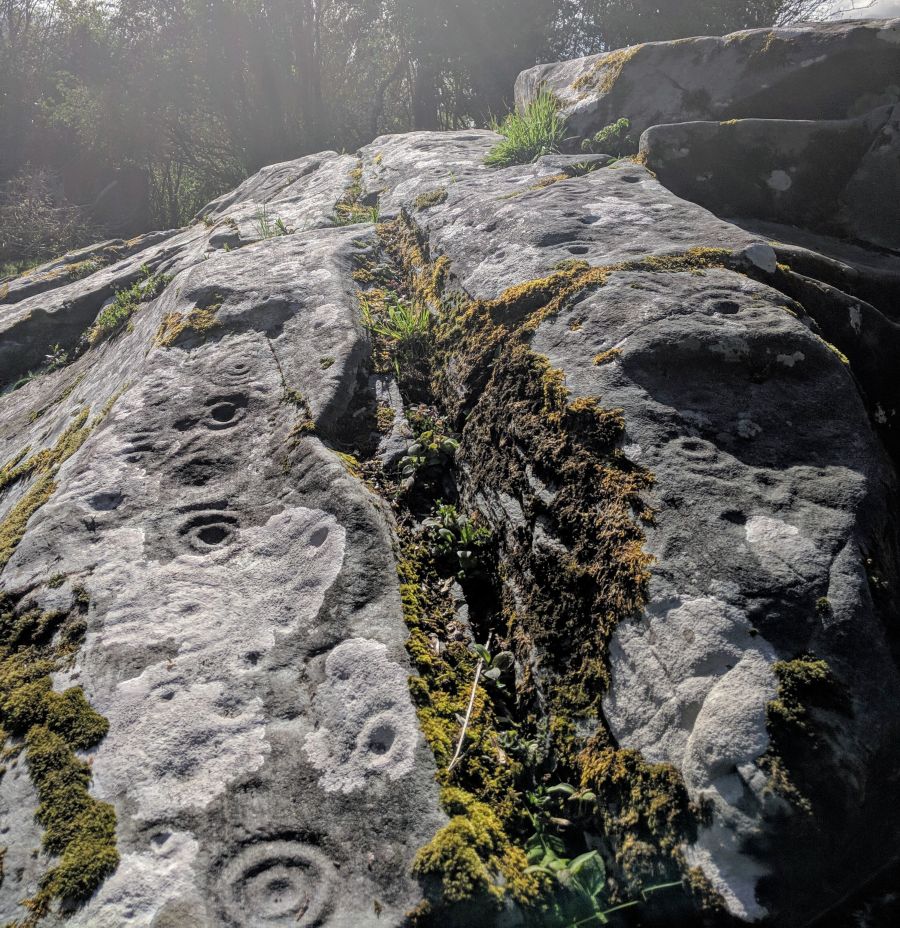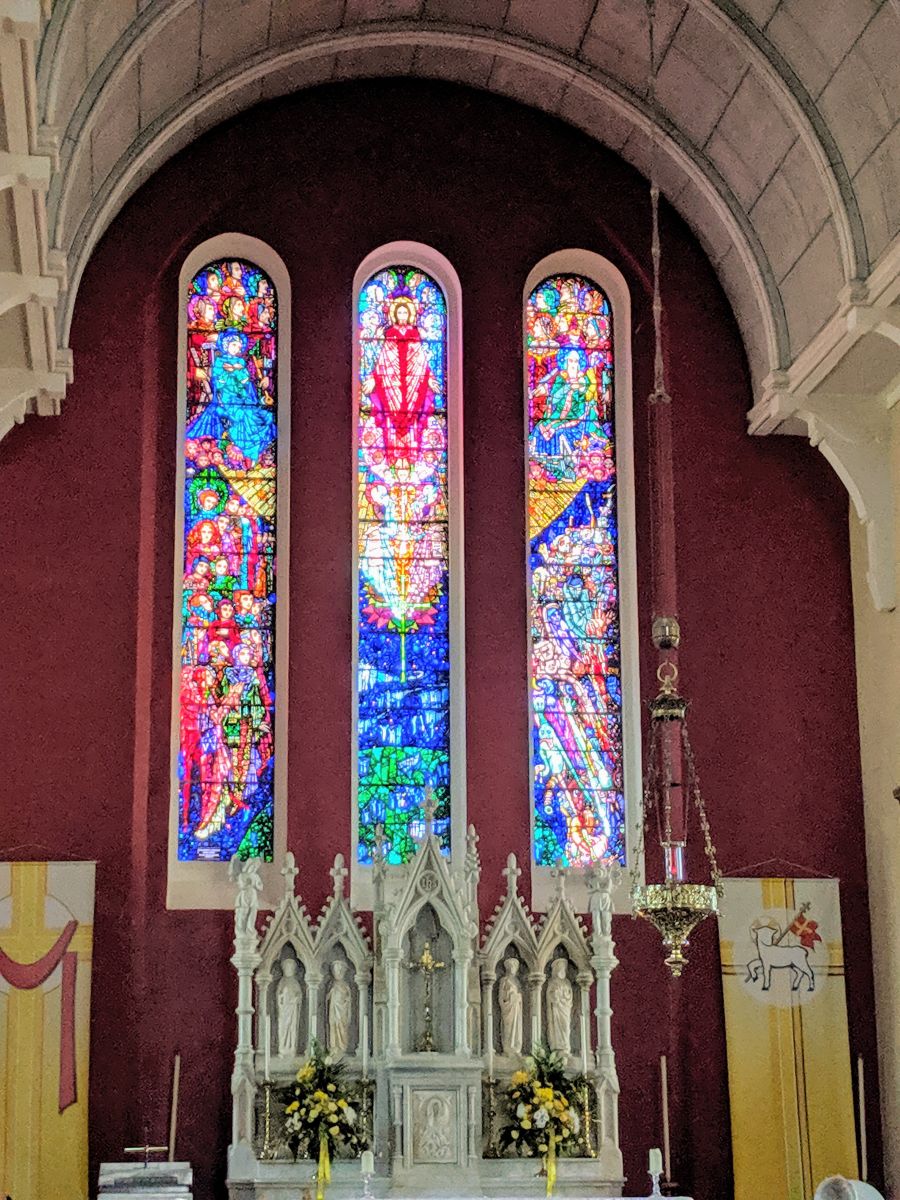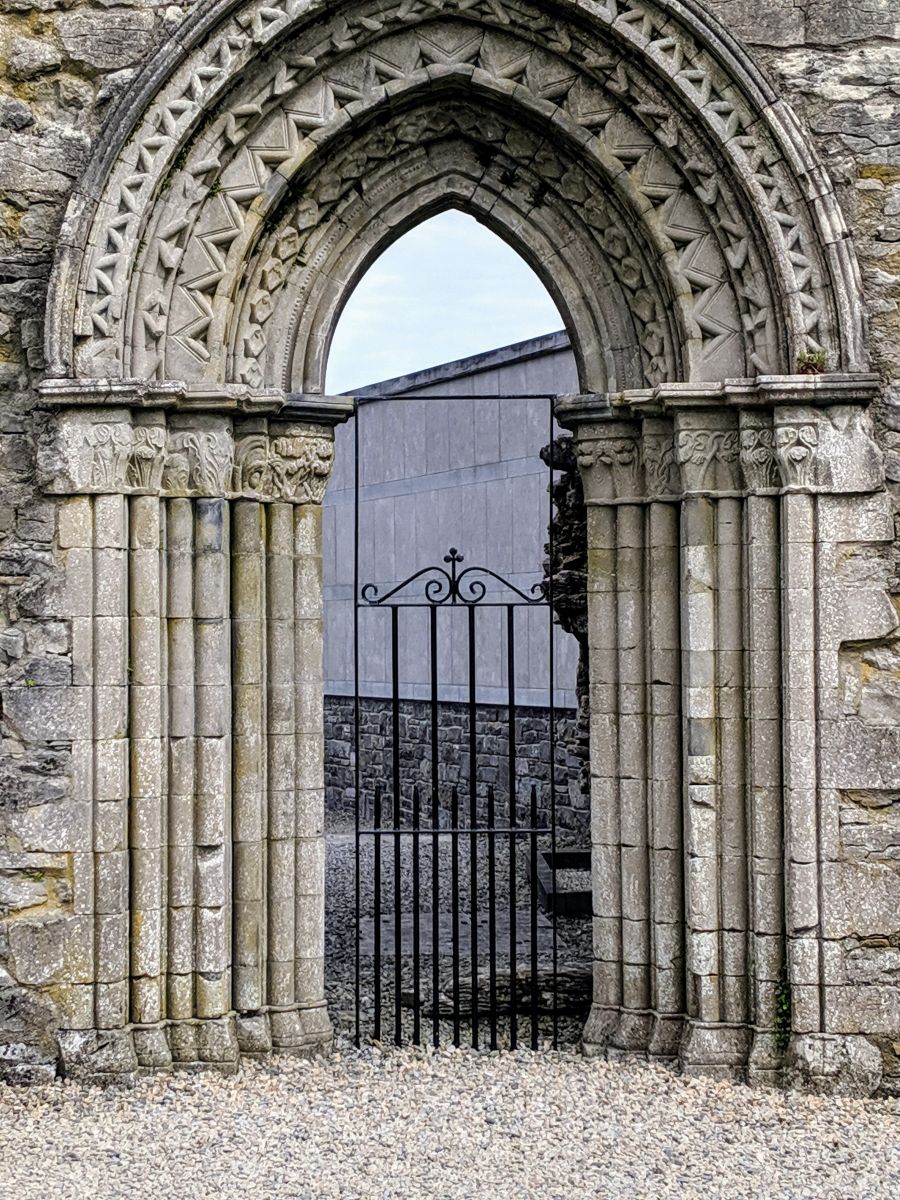A group of 31 members of the Society have just completed a historic trip to West Mayo, based in the Castlecourt Hotel Westport in association with JMG Travel from 12 – 15 May 2019.
The first stop en route was in the historic town of Athlone, the geographical centre of Ireland on the banks of the Shannon and best known as the ‘gateway’ to the West. Dismounting in Northgate Street, the top of which is where the north gate in the old town walls once stood. Located nearby is the former workhouse (now St Vincent’s care centre) and further along the street is the Methodist church with its outstanding example of Gothic Revival architecture. Crossing the bridge, which is a magnificent arched limestone structure, the skyline on the west is captured by the twin spires and the Italianate dome of St. Peter and Paul’s Church and the imposing structure of Athlone Castle. During the visit to the Castle, the members heard the story of the settlement here in Athlone from the Neolithic period through the Viking and medieval ages up to present day life in Athlone. The Castle has been the scene of various sieges and battles, in particular, during the Williamite – Jacobite War witnessing the heroics of one Sergeant Costume from whom the local army barracks takes its name. Within the Castle there is a visitor centre with exhibitions such as the Williamite Siege of Athlone and of course Count John McCormack, the famous tenor, who was born in the town in 1884.
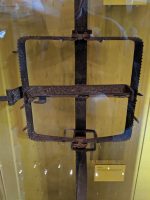
Man Trap
There is a wonderful display of artefacts telling the story of the area down through the ages to the present day. These include the evangelist sandstone slab from the early Christian period featuring the depiction of St Mark and St Luke and a ‘man-trap’ such as those used in the former landed estates in the eighteenth and nineteenth century to distract trespass by the local peasants in search of game or timber. Some members found time to visit the nearby Luan Gallery where there is a magnificent display of art from around the midlands. The Gallery opened in 2012 taking its name from the mystical chief Luan from whom the town also takes its name. Part of the Gallery is housed in a beautifully restored building constructed in 1897 as a temperance hall.
Cong
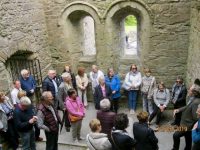
Dr Robert Scott speaking in the Abbey
After lunch in Ryan’s Hotel in Cong members were brought on a guided tour by Dr Robert Scott who operates the ‘Rare and Recent’ bookshop in the village. Robert spoke of Cong’s many historical attributes such as; the Cross of Cong, which is made from oak and covered with elaborate ornate metal decoration dating back to 1123, it once containing a relic of the true cross which is now on display in the National Museum. Ashford Castle which is south of the village on the shore of Lough Corrib was acquired by the Guinness family in the mid nineteenth century but it no longer belongs to the family and is now a luxury hotel. Robert’s tour began with the Market Cross in the centre of the Main Street which he suggested could have been part of a stone cross erected to commemorate the completion of the Cong Abbey in the twelfth century. However, all that remains now of the original cross is the plinth holding a plain 1930 stone sculpture. The first monastic site, we were informed, is said to have been founded in seventh century and the Abbey was re-founded in 1138 by Turlough O’Connor, King of Connacht and High King of Ireland, as an Augustinian house. It is reputed that Rory O’Connor, the last High King of Ireland, died at this site. The Abbey was rebuilt in the thirteenth century and served as a hospital, shelter for the poor, and a place of learning in addition to its other religious functions.
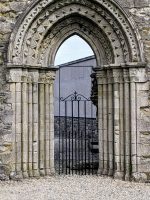
Doorway at Cong Abbey
The Abbey fell into ruin following the dissolution of the monasteries by Henry VIII, however, some restoration works were carried out in the late nineteenth century by Benjamin Guinness, then owner of Ashford Castle. Here our guide sounded a note of caution regarding the restoration, particularly, in relation to the area of the cloisters. Nevertheless, it has many outstanding features with doorways being examples of Romanesque and Gothic architecture. Down the steps from the cloisters by way of a short pathway is the Monk’s Fishing House and also Macnemara’s house whose owner, Robert Scott referred to as the ‘Robin Hood’ of Cong. There were many other sites to see in this most idyllic village which time did not allow such as the Dry Canal, on which work began in 1848 and abandoned in 1854 and of course Ashford Castle. Cong in more modern times will be most remembered as the main location for the filming of the ‘Quiet Man’ starring John Wayne and Maureen O’Hara.
Day one was completed with Dinner in the Castlecourt Hotel restaurant where the guest of honour was Professor Seamas Caulfield of Ceide Fields fame. Seamas grew up in the scenic costal village of Belderrig where his father Patrick was the local school teacher and amateur archaeologist. Back in 1963, together with his father, Seamas organised a field trip to the area led by Professor Ruaidhrí de Valera and students from UCD and so began a journey that would put Belderrig and the Céide Fields on the archaeological map for ever. To conclude the President made a presentation to Seamas in recognition of his lifetime contribution to archaeology and in return Seamas presented a copy of his 2015 publication; “Guide to Belderrig’s Ancient Farms’ to all the members.
Day 2
On day two the first stop was in Newport where the party was met by local historian Peter Mullowney. A Veterinary Surgeon by profession, who, on retirement completed a MA under professor Raymond Gillespie in Maynooth University, Peter introduced the party to Newport’s historical past, for example the town’s relatively recent establishment by the Medlycott family in the early eighteenth century and the exploits of Grace O’Malley (Gráinne Úaile) in the sixteenth century. The town once had a thriving linen industry under the management of immigrant Quakers and in more later times a lace making industry. The O’Donel family, a branch of the Donegal chieftains, purchased the Medlycott estate and were responsible for building Newport House. Two of the most outstanding features of Newport are the seven arch railway bridge built over the Blackoak river to facilitate the branch railway to Achill and the imposing St Patrick’s Church on Barrack Street overlooking the town and the adjoining countryside.
The bridge is a magnificent structure with a mixture of red sandstone and limestone built in 1892 by the Midland Great Western Railway at a cost of £7,000 and now part of the Western Greenway. The railway, which began operating in 1894, was part of a British administration initiative to assist disadvantage areas, was never a success and closed in 1937. This railway is best remembered by the natives of the area from the well documented seventeenth century prophecy by Achill native Brian Rua Ó Cearabháin, who foretold that horseless carriages blowing fire and smoke on their first and last journeys would carry corpses. The first part of the prophecy came true in June 1894 when a party of ‘tattie-hoking’ Achill islanders en route to Scotland, thirty-two of whom were drowned near the quay in Westport when their sailing boat capsized. The railway line was opened specifically to transport their remains to Achill. Tragedy was to repeat itself in September 1937 when ten young boys from Achill engaged in ‘tattie-hoking’ on a farm outside Glasgow perished in a fire in their locked bothy. The railway which had closed some years earlier was re-opened to enable the bodies to be transported back to Achill thereby fulfilling the prophecy.
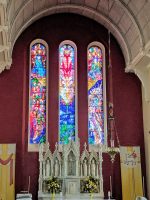
The Harry Clarke stained glass windows
St Patrick’s is a detached eight-bay Catholic church designed by the Dublin architect R. M. Butler (1872-1943) and the sandstone dominated structure was built by John Sisk & Son between 1914-18. It was built at the request of the then Parish Priest, Very Rev. Canon Michael McDonald – who was responsible for the building of the oratory on the summit of Croagh Patrick. The church attracts many visitors who come specially to admire the work and design of the legendary Harry Clarke (1889-1931) of the stained-glass window on the east wall over the High Altar. While the window is commonly known as; ‘The Last Judgement Window”, it consists of three parts of equal size and is frequently referred to as; the ‘The Three Sisters’ It was the last work executed by Harry Clarke and installed in the church in February 1931 shortly after death. Canon McDonald cashed his life insurance policy to pay the £800 cost of the window. The church has many other interesting features including the magnificent western doorway and beautifully restored altar.
Ballycroy
Having had a most enjoyable visit to Newport the group moved on to Ballycroy National Park visitor centre. After some relaxation in the lovely Ginger & Wild Café and fortified with nice coffee and scones and views of the vast Atlantic blanket bog, the staff at the centre gave a most informative presentation on the National Park itself which covers a vast area of 11,000 hectares of blanket bog cover, which in itself is an important scientific feature. It is dominated by the Nephin Beg mountain and is part of a Special Area of Conservation (SAC) and a Special Protected Area. There were a number of stunning displays and had many of our members wondering why such a status and management cannot be conferred on the Curragh. Michael Chambers, a member of the staff, gave an account of his own experience of the area and its social history. Having explored all the displays of flora, fauna, geological, historical and explored part of the outside trail it was decided to make a surprise stop in Belderrig.
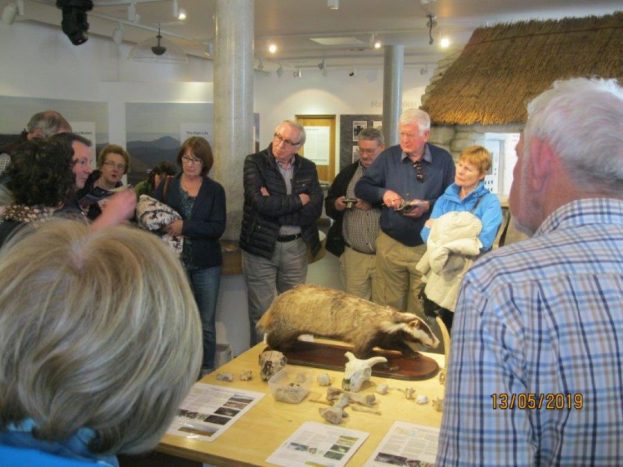
Michael Chambers in conversation with the members
Belderrig
On the approach to Belderrig Seamas Caulfield was waiting to board the coach and continuing from where he had left off the previous evening Seamas outlined many of features he had spoken about and recorded in his publication. The scenic coastal Belderrig area spans the Atlantic Ocean between Ballycastle and Belmullet in North Mayo and with the help of the glorious weather it was possible to see the Stags of Broadhaven, the Sligo coastline and distant Slieve League in Donegal. In the midst of this stunning backdrop of ocean, sea-cliffs and dramatic mountains, hidden away was this important trove of rich, social, historical and archaeological heritage waiting to be discovered initially by Seamas’ father and later under Seamas’ leadership. At the Belderrig Ancient Farm Seamas outlined the method of research and some of the technique used such as the probing bar either of iron or wood to assist in establishing the location of the stone walled field systems buried beneath the bog which has been growing for thousands of years. The party heard about the discovery of plough-marks, (Scotch) pine trees, crop ridges, Neolithic pottery and the excavation of the Round house. Finishing our visit to Belderrig, Seamas pointed out the school where his father taught for his lifetime – now like so many rural schools closed up, his parents’ home, his summer home by the sea and pride of place the stone to mark the visit by the late Seamus Heaney with the words of his Belderrig poem carved thereon. The essence of the Belderrig (‘Belderg’) landscape was captured by Seamus Heaney in a poem accompanying a thank-you letter shortly after a visit to Patrick Caulfield’s (Seamus’s father’s) house in 1974.
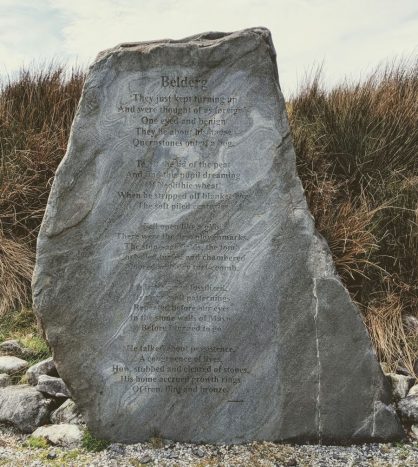
“Belderg”
Belderg
‘They just keep turning up
And were thought of as foreign’-
One-eyed and benign,
They lie about his house,
Quernstones out of a bog.
To lift the lid of the peat
And find this pupil dreaming
Of neolithic wheat!
When he stripped off blanket bog
The soft-piled centuries
Fell open like a glib;
There were the first plough marks,
The stone-age fields, the tomb
Corbelled, turfed and chambered,
Floored with dry turf-coomb.
A landscape fossilized,
Its stone wall patternings
Repeated before our eyes
In the stone walls of Mayo.
Before I turned to go
He talked about persistence,
A congruence of lives,
How stubbed and cleared of stones,
His home accrued growth rings
Of iron, flint and bronze.
The Céide Fields
Accompanied by Seamas the members moved on to the Céide Fields (Céide in Irish meaning ‘a flat topped hill’). En route Seamas gave an interesting account of the social history of the area including the suffering endured during the Great Famine, the Land War, the War of Independence and the Civil War.
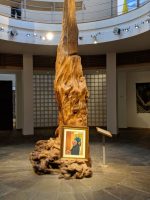
The Scots Pine Tree with a painting of Seamas and his late father Patrick
He spoke of the Westminster plan for a railway line from Dublin to Blacksod Bay in Mayo where a transatlantic shipping terminal would be set up, however, this was shelved due to the outbreak of World War I. The members were welcomed in the Visitor’s Centre by the archaeologist in charge, Gretta Byrne. After some relaxation and a lovely lunch in the Centre, Gretta and Seamus gathered the members around the tree which forms the centrepiece of the Visitors Centre. This massive Scots Pine (Pinus Sylvestris) tree which is now upright was preserved for more than four thousand years because it had been blown down. Seamas pointed out the axe marks on the trunk roots which he said resulted from his father’s attempt many years ago while attempting to remove an obstruction from a bog drain. The significance of this tree and the others found in Belderrig is that they are associated with early field walls and provide incontrovertible evidence that the field systems which underlie the bogs on which these trees grew must date to the fourth millennium BC making them the earliest field systems in Europe. Afterwards the members were broken up into two groups with the more adventurous members following Seamas through a large part of this Neolithic or Stone Age landscape. There were opportunities to test individual skills in probing for both groups and to interpret the wonderful archaeological research carried out at the Céide Fields.
After a superb day exploring Newport, Ballycroy, Belderrig and the Céide Fields the party were joined for Dinner by Brónach Joyce from the Westport Historical Society. Brónach, on extending a most sincere welcome, proceeded to outline the activities of her Society including its annual Journal and the Clew Bay Heritage Centre.
Day 3
The day consisted of an intensive archaeological trail under the guidance of Michael Gibbons, one of Ireland’s leading field Archaeologists, beginning with a visit to the Boheh Stone. Located a short distance south of Westport on the N59, the Stone is also known as St Patrick’s chair which is a large outcrop of rock decorated with an excellent example of Neolithic rock art consisting of carvings of cupmarks, circles and keyhole motifs some of which resembles those found in New Grange. The stone has a connection with Croagh Patrick and its pilgrimage trail. The dates 18 April and 24 August are of special significance in that; the sun appears to set on the summit of Croagh Patrick and from the Beheh Stone it then rolls down the mountain side revealing the ‘rolling sun’. Many believe this signifies the beginning and end of the growing season.
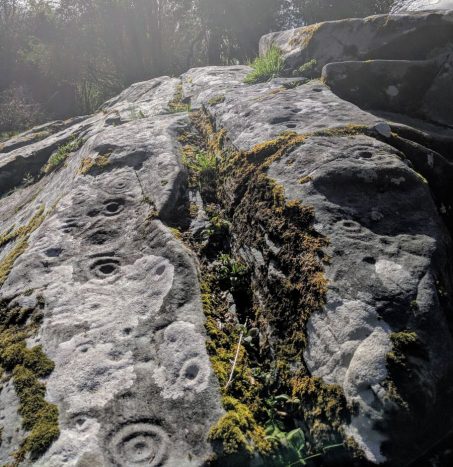
The Bohey Stone
Annagh-Killadangan
Moving on from the Boheh site there was a stop at the megalithic complex of Annagh-Killadangan, again, in the shadow of Croagh Patrick and dating from the Bronze age. Located on a salt marsh on the southern shore of Clew Bay approximately 5 kilometres west of Westport. This complex has a number of important archaeological features such as; a row of five stones (one of which has fallen), an oval shaped enclosure, a possible stone circle and a fulacht fiad. Perhaps, the most remarkable part is the row of stones facing Croagh Patrick, the height of which increases from north to south and during the winter solstice (21st of December) the sun dips into a niche on the mountainside.
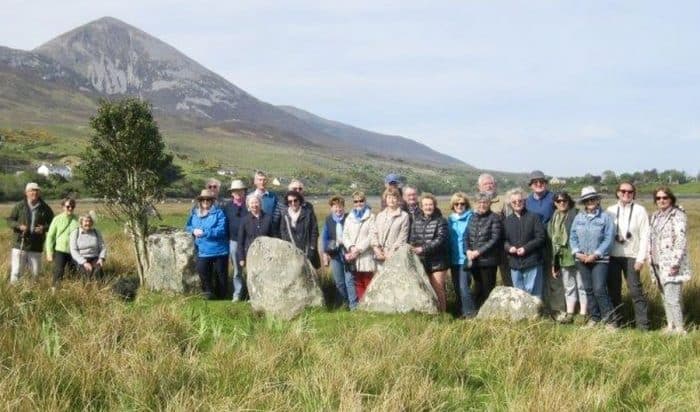
Members at Annagh-Killadangan
National Famine Memorial and Murrish Abbey
Following a quick break for some nice tea and coffee served by the proprietor, Pat Holmes of Campbells, at the foot of Croagh Patrick together with lovely freshly baked scones by his wife Lorraine the members crossed the road to view the National Famine Memorial. This remarkable bronze sculpture by John Behan was unveiled by President Mary Robinson in 1997. This monument commemorates Ireland’s greatest disaster when millions of our people perished during the Great Irish Famine of the 1840s and depicts the skeletal figures of the starving aboard the ‘coffin ship’ with the unfortunate emigrants fleeing the countryside in unsuitable overcrowded boats. Just some 200 metres north of the Memorial, in a tranquil remote setting on the shore of Clew Bay, is the ruined Augustinian Murrish Abbey established circa 1456. Dedicated to St Patrick it quickly became the preferred starting point for pilgrimages up Croagh Patrick. The ruins include a beautiful east window with carved human heads on the wall outside while the south wall is crowned with unusual battlements and a number of trefoil and ogee-headed windows.
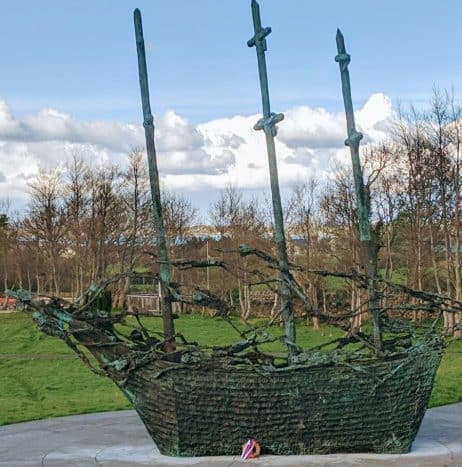
The National Famine Memorial
Killeen
Continuing the archaeological trail we travelled westwards along the south of Clew Bay through the historic town of Louisburgh. Immediately afterwards, where Clew Bay joins with the Atlantic Ocean, the members were met in the distance with the majestic vista of Clare, Cahar and Innishturk islands. Michael Gibbons continued to swamp us with the history and folklore of the area, stopping briefly at Killeen graveyard to view a spectacular large leaning stone, which was Christianised during the seventh century with a Maltese Cross. An early Christian church once stood at this site and while there is no trace of this church, tradition has it, that if a person found guilty of any crime placed a finger in the keyhole of the church door, he/she would be let go free. Moving onwards, Michael outlined a number of important archaeological features in this area and pointed out the location where Michael Viney has made his home. The distinguished Brighton born author, broadcaster and journalist, is noted for his weekly column on nature which many of us follow weekly in the Irish Times.
Srahwee Tomb and the ancient forest
The Srahwee or Altóir wedge tomb is located in Cregganbaun some seven kilometres south of Louisburgh. Wedge tombs are so called because of their wedge shape and Srahwee Tomb is regarded as one of the finest example of megalithic tombs found in Ireland and it dates to the Bronze Age (2,000 BC). In size it is approximately five metres by two metres, it is wider and higher at the entrance and tapers back towards its rear with double walling of the gallery and is partially covered by a large flat roof slab circa two metres square. The entrance to the tomb is partially closed by a door stone. The flat roof stone was used as an altar for the celebration of Mass during Penal times, thereby, giving the tomb its local name, Altóir or altar and a small primitive cross has been carved into the surface at its south-eastern end. After much debate on the purpose and use of this magnificent archaeological specimen, Michael then brought the members to the side of the nearby lake, Lough Nahaltora or as known in the past times, the holy well, to point out one of the finest examples of an ancient forest of Scots Pine trees. While the forest is long gone the stumps of the ancient trees still protrude from the brown lake waters and the cutaway bog. These trees have been dated to 2,500 BC and 500 years before the nearby tomb was built.
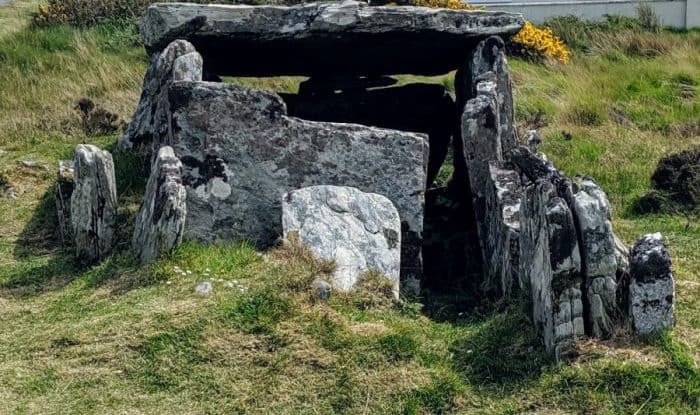
Srahwee Tomb
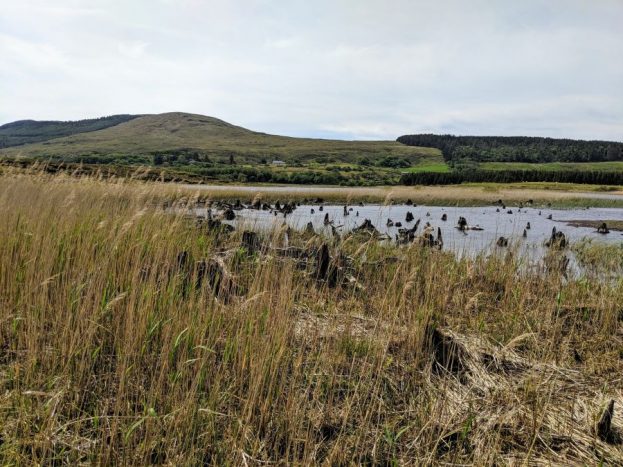
The ancient forest
Glen Keen Farm & Visitor Centre
There was a stop off for lunch at Glen Keen Farm & Visitor Centre where, John Lyons a local historian, dropped in to greet the Society members and to give an interesting outline of Louisburgh and its hinterland over the centuries including the arrival of St Patrick, the adventures of Grace O’Malley, the Pirate Queen, to the tragedy of the Great famine. Louisburgh itself was a planned town built at the end of the eighteenth century by John D. Browne, the third Earl of Altamount who later became the first Marquess of Sligo . Its purpose was to house Catholic refugees who had fled the north of Ireland due to sectarian unrest. The town is said to take its name from its namesake Louisburg in Nova Scotia.
Doolough Tragedy
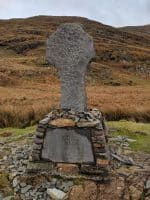
Doo Lough Famine Memorial
Moving on from Glen Keen Farm there was a brief stop at the Doo Lough Famine Memorial which is a plain cross engraved with the words; ‘Doolough Tragedy 1849’. The memorial commemorates upwards of 600 starving people who had gathered in Louisburgh seeking food or a ticket to Westport workhouse. They were told to report to the Poor Law officials who were meeting the next day at Delphi Lodge, a journey in those days of around twenty kilometres through sheep tracks and wading streams. Some died overnight en route in the cold and wintry conditions and those who arrived at Delphi were refused any help and told by the Poor Law officials, who had just risen from lunch, to return to where they had come from. There are no conclusive figures as to the number who perished from cold, hunger and exhaustion, however, the figure was substantial and many were buried where they fell.
Killary fjord and Aasleagh Falls Travelling along the northern side of Killary fjord that divides Connermara in Co. Galway from south county Mayo there was a brief stop at the quaint unknown children’ graveyard. Located on the banks of the fjord it is also the place of rest for an unknown adult and is beautifully maintained by the land owner Peter Wallace. The final stop of the day was at the nearby picturesque Aasleagh Falls on the river Erriff a short distance from where tit discharges into the fjord. Later on return to the Hotel, the President, on behalf of the Society paid tribute to Michael Gibbons for providing the members with such a fantastic tour so full of information and wit. He also thanked Michael for giving so much time during the planning of the trip.
Travelling along the northern side of Killary fjord that divides Connermara in Co. Galway from south county Mayo there was a brief stop at the quaint unknown children’ graveyard. Located on the banks of the fjord it is also the place of rest for an unknown adult and is beautifully maintained by the land owner Peter Wallace. The final stop of the day was at the nearby picturesque Aasleagh Falls on the river Erriff a short distance from where tit discharges into the fjord. Later on return to the Hotel, the President, on behalf of the Society paid tribute to Michael Gibbons for providing the members with such a fantastic tour so full of information and wit. He also thanked Michael for giving so much time during the planning of the trip.
Day 4
The forenoon of the final day of the excursion was devoted to Westport town beginning at Clew Bay Heritage Centre located in a nineteenth century building on Westport Quay. Following a formal greeting by Brónach Joyce who then traced the history of the planned town of Westport from pre-Christian times to the present using a magnificent scaled model. The members then availed of the superb display of artefacts and documents related to Westport and the general area together with the farm implements displayed outside. Brónach followed up with a walkabout of the town’s main features starting on the quayside with the Memorial to the thirty-two Achill islanders drowned in Clew Bay in June 1894 en route to Glasgow (mentioned earlier), the tasteful redevelopment of the old decayed buildings lining the harbour area and the birthplace of Major John MacBride, executed for his role in the 1916 Rising, husband of Maud Gonne and father of Sean MacBride the Nobel Peace Prize winner and Irish politician. Proceeding to the town centre, Brónach recommenced her town walk at Westport’s prominent ‘octagonal monument’ overlooking the town. This monument was originally erected in the 1840s consisting of a grooved stone column on an octagon plinth with a statue of George Clendening on top in recognition for his services to Westport, however, Clendening was replaced with a Portland stone statue of St Patrick in 1990.
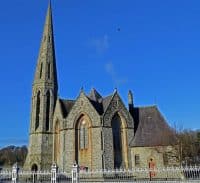
Holy Trinity Church
The construction of the Mall involved the diversion of the Carrowbeg river to flow through it creating two tree lined streets. These works coincided with a new entrance and Gate Lodge for Westport House, while the Lodge remains, the entrance has made way by means of a compulsory purchase by the County Council, for the provision of local authority housing some years ago. Nevertheless, the walkabout revealed what a vibrant and cultural town Westport is, especially, its many magnificently architecturally designed buildings. One of these is Holy Trinity church consecrated in 1872 having replaced an earlier Church of Ireland situated in the grounds of Westport House demesne. Designed by Thomas Newenham Deane in Gothic architectural style and ornately decorated, especially, the stained glass windows above the Communion Table which depicts the Saints Matthew, Mark, Luke and John.
The excursion was brought to a conclusion with a celebratory Dinner on the way back to Naas at the Hodson Bay Hotel on the banks of the Shannon. I would like to thank all those who helped to make this excursion a wonderful success.
Hugh Crawford
President





